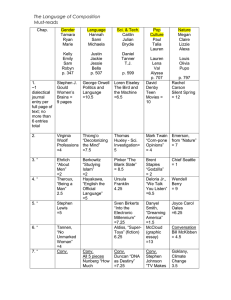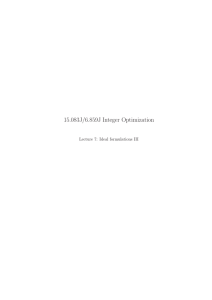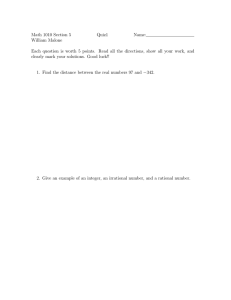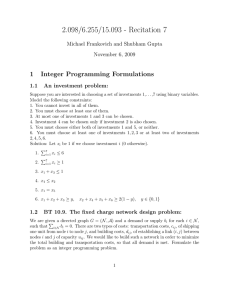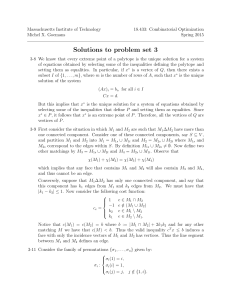Document 13449646
advertisement
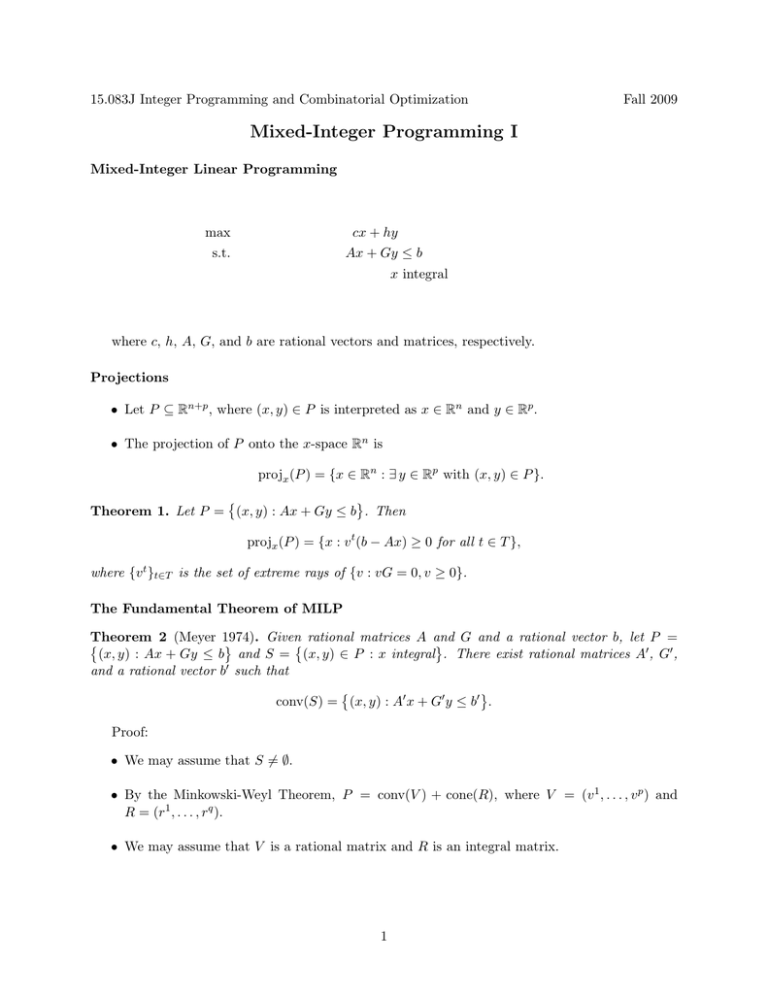
15.083J Integer Programming and Combinatorial Optimization
Fall 2009
Mixed-Integer Programming I
Mixed-Integer Linear Programming
max
cx + hy
Ax + Gy ≤ b
s.t.
x integral
where c, h, A, G, and b are rational vectors and matrices, respectively.
Projections
• Let P ⊆ Rn+p , where (x, y) ∈ P is interpreted as x ∈ Rn and y ∈ Rp .
• The projection of P onto the x-space Rn is
projx (P ) = {x ∈ Rn : ∃ y ∈ Rp with (x, y) ∈ P }.
�
�
Theorem 1. Let P = (x, y) : Ax + Gy ≤ b . Then
projx (P ) = {x : v t (b − Ax) ≥ 0 for all t ∈ T },
where {v t }t∈T is the set of extreme rays of {v : vG = 0, v ≥ 0}.
The Fundamental Theorem of MILP
Theorem 2 (Meyer 1974).
Given� rational matrices A and
�
�
� G and a rational vector b, let � P =
(x, y) : Ax + Gy ≤ b and S = (x, y) ∈ P : x integral . There exist rational matrices A , G� ,
and a rational vector b� such that
�
�
conv(S) = (x, y) : A� x + G� y ≤ b� .
Proof:
• We may assume that S =
� ∅.
• By the Minkowski-Weyl Theorem, P = conv(V ) + cone(R), where V = (v 1 , . . . , v p ) and
R = (r1 , . . . , rq ).
• We may assume that V is a rational matrix and R is an integral matrix.
1
• Consider the following truncation of P :
p
q
p
�
�
�
�
T = (x, y) : (x, y) =
λi v i +
µj r j ,
λi = 1,
i=1
j=1
i=1
�
λ ≥ 0, 0 ≤ µ ≤ 1 .
• T is bounded and is the projection of a rational polyhedron. It therefore is a rational polytope.
�
�
• Let TI = (x, y) ∈ T : x integral . Claim: conv(TI ) is a rational polytope.
�
�
• Since T is a polytope, X = x : ∃ y s.th. (x, y) ∈ TI is finite.
�
�
• For fixed x̄ ∈ X, Tx̄ = (x̄, y) : (x̄, y) ∈ TI is a rational polytope. Hence, Tx̄ = conv(Vx̄ ) for
some rational matrix Vx̄ .
• Since X is finite, there is a rational matrix VTI which contains all the columns of all matrices
Vx̄ , for x̄ ∈ X.
• Therefore, conv(TI ) = conv(VTI ), which proves the claim.
• (x̄, ȳ) ∈ S iff x̄ is integral and there exist λ ≥ 0,
(x̄, ȳ) =
p
�
i=1
• The point
�p
i=1 λi v
i
+
�q
j =1 (µj
�p
i=1 λi
= 1, and µ ≥ 0 such that
q
q
�
�
j
λi v +
(µj − �µj �)r +
�µj �rj .
i
j=1
j=1
− �µj �)rj belongs to T .
• Since x̄ and �µj �rj are integral it also belongs to TI .
• Thus
S = TI + RI ,
where RI is the set of integral conic combinations of r1 , . . . , rq .
• (1) implies that
conv(S) = conv(TI ) + cone(R).
• By the above claim conv(TI ) is a rational polytope.
• Thus conv(S) is a rational polyhedron (having the same recession cone as P ).
Union of Polyhedra
• Consider k polyhedra Pi = {x ∈ Rn : Ai x ≤ bi }, i = 1, . . . , k.
• One can show that conv(∪ki=1 Pi ) is a polyhedron.
2
(1)
• Furthermore, we will show that this polyhedron can be obtained as the projection onto Rn
of a polyhedron with polynomially many variables and constraints in a higher-dimensional
space.
• (The closure is needed: let P1 be a single point and let P2 be a line that does not contain P2 .)
Theorem 3. For i = 1, . . . , k, let Pi = Qi + Ci be nonempty polyhedra. Then Q = conv(∪ki=1 Qi )
is a polytope, C = conv(∪ki=1 Ci ) is a finitely generated cone, and conv(∪ki=1 Pi ) = Q + C.
• No proof here, but note that the claims on Q and C are straightforward to check.
• One consequence of the proof is that if P1 , . . . , Pk have identical recession cones, then conv(∪ki=1 Pi )
is a polyhedron.
Theorem 4 (Balas 1974). Consider k polyhedra Pi = Qi + Ci = {x ∈ Rn : Ai x ≤ bi } and let
Y ⊆ Rn+kn+k be the polyhedron defined by
Ai xi ≤ bi yi ,
k
�
xi = x,
i=1
k
�
yi = 1, yi ≥ 0 for i = 1, . . . , k.
i=1
Then
projx (Y ) = Q + C,
where Q =
conv(∪ki=1 Qi )
and C = conv(∪ki=1 Ci ).
Proof:
• First, let x ∈ Q + C.
• There exist wi ∈ Qi and z i ∈ Ci such that x =
• Let xi = yi wi + z i . Then Ai xi ≤ bi yi and x =
�
i yi w
�
i
+
�
iz
i,
where yi ≥ 0 and
i
ix .
• This shows x ∈ projx (Y ).
• Now, let x ∈ projx (Y ).
• There exist x1 , . . . , xk , y such that x =
�
ix
i
where Ai xi ≤ bi yi ,
�
i yi
= 1, y ≥ 0.
• Let I = {i : yi > 0}.
• For i ∈ I, let z i =
xi
yi .
Then z i ∈ Pi .
• Since Pi = Qi + Ci , we can write z i = wi +
ri
yi
where wi ∈ Qi and ri ∈ Ci .
• For i �∈ I, we have Ai xi ≤ 0, that is xi ∈ Ci . Let ri = xi for i �∈ I.
• Then,
x=
�
i∈I
yi z i +
�
xi =
i�∈I
�
i∈I
3
yi wi +
�
i
ri ∈ Q + C.
�
i yi
= 1.
Lift-and-Project Revisited
We consider mixed-0/1 linear programs:
min
cx
Ax ≥ b
s.t.
xj ∈ {0, 1}
for j = 1, . . . , n
xj ≥ 0
for j = n + 1, . . . , n + p
p
n
We let P = {x ∈ Rn+p
+ : Ax ≥ b} and S = {x ∈ {0, 1} × R+ : Ax ≥ b}.
We assume that Ax ≥ b includes −xj ≥ −1 for j = 1, . . . , n, but not x ≥ 0.
•
Given an index j ∈ {1, . . . , n}, let
�
�
Pj = conv (Ax ≥ b, x ≥ 0, xj = 0) ∪ (Ax ≥ b, x ≥ 0, xj = 1) .
• By definition, this is the tightest possible relaxation among all relaxations that ignore the
integrality of all variables xi , i =
� j.
•
�
n
j=1 Pj
is called the lift-and-project closure:
conv(S) ⊆
n
�
Pj ⊆ P.
j=1
• On 35 mixed-0/1 linear programs from MIPLIB, the lift-and-project closure reduces the
integrality gap by 37% on average [Bonami & Minoux 2005].
Lift-and-Project Cuts
Pj is the convex hull of the union of two polyhedra:
Ax ≥ b
Ax ≥ b
x≥0
x≥0
and
−xj ≥ 0
xj ≥ 1
By the above theorem:
Ax0
⎜
−x0j
⎜
⎜
Ax1
⎜
x
1j
Pj = projx ⎜
⎜
0
⎜
x
+ x1
⎜
⎝
y 0 + y1
0
1
x
, x
, y0 , y1
⎛
4
≥
≥
≥
≥
=
=
≥
by0
0
by1
y1
x
1
0
⎞
⎟
⎟
⎟
⎟
⎟
⎟
⎟
⎟
⎠
• Using the projection theorem, we get that Pj is defined by the inequalities αx ≥ β such that
−uA +u0 ej
α
α
−vA −v0 ej
β
β
−ub
u,
u0 ,
−vb
v,
−v0
v0
≥
≥
≤
≤
≥
0
0
0
0
0
(2)
• Such an inequality αx ≥ β is called a lift-and-project inequality.
• Given a fractional point x̄, we can determine if there exists a lift-and-project inequality αx ≥ β
valid for Pj that cuts off x̄.
• This problem amounts to finding (α, β, u, u0 , v, vo ) satisfying (2) such that αx̄ − β < 0.
• In order to find a “best” cut in cone (2), we solve the cut-generating LP:
min αx̄ −β
−uA +u0 ej
α
−vA −v0 ej
α
β
−ub
β �
−v0
�−vb
u
+u
+
v
+v0
0
i i
i i
v,
v0
u,
u0 ,
≥
≥
≤
≤
=
≥
0
0
0
0
1
0
Mixed Integer Inequalities
p
n
�
�
�
�
• Consider S = (x, y) ∈ Zn+ × Rp+ :
aj xj +
gj yj = b .
j=1
j=1
• Let b = �b� + f0 where 0 < f0 < 1.
• Let aj = �aj � + fj where 0 ≤ fj < 1.
• Then
�
fj ≤f0
�
fj xj +
(fj − 1)xj +
p
�
gj yj = k + f0 , where k is some integer.
j=1
fj >f0
• Since k ≤ −1 or k ≥ 0, any x ∈ S satisfies
p
� fj
� 1 − fj
�
gj
xj −
xj +
yj ≥ 1
f0
f0
f0
fj ≤f0
OR
�
−
fj ≤f0
• This is of the form
x ≥ 0.
�
j
p
� 1 − fj
�
fj
gj
xj +
xj −
yj ≥ 1.
1 − f0
1 − f0
1 − f0
a1j xj ≥ 1 or
fj >f0
�
j
(3)
j=1
fj >f0
a2j xj ≥ 1, which implies
5
(4)
j=1
�
j
max{a1j , a2j }xj ≥ 1 for any
• For each variable, what is the max coefficient in (3) and (4)?
• We get
� fj
� 1 − fj
� gj
� gj
xj +
xj +
yj −
yj ≥ 1.
f0
1 − f0
f0
1 − f0
fj ≤f0
gj >0
fj >f0
gj <0
• This is the Gomory mixed integer (GMI) inequality.
• In the pure integer programming case, the GMI inequality reduces to
� fj
� 1 − fj
xj +
xj ≥ 1.
f0
1 − f0
fj ≤f0
• Since
1−fj
1−f0
<
fj
f0
fj >f0
when fj > f0 , the GMI inequality dominates
n
�
fj xj ≥ f0 ,
j=1
which is known as the fractional cut.
�
�
• Consider now S = (x, y) ∈ Zn+ × Rp+ : Ax + Gy ≤ b .
�
�
• Let P = (x, y) ∈ Rn+ × Rp+ : Ax + Gy ≤ b be the underlying polyhedron.
• Let αx + γy ≤ β be any valid for P .
• Add a nonnegative slack variable s, use αx + γy + s = β to derive a GMI inequality, and
eliminate s = β − αx − γy from it.
• The result is a valid inequality for S.
• These inequalities are called the GMI inequalities for S.
• In contrast to lift-and-project cuts, it is in general NP-hard to find a GMI inequality that
cuts off a point (x̄, ȳ) ∈ P \ S, or show that none exists.
• However, one can easily find a GMI inequality that cuts off a basic feasible solution.
• On 41 MIPLIB instances, adding the GMI cuts generated from the optimal simplex tableaux
reduces the integrality gap by 24% on average [Bonami et al. 2008]
• GMI cuts are widely used in commercial codes today.
• Numerical issues need to be addressed, however.
6
MIT OpenCourseWare
http://ocw.mit.edu
15.083J / 6.859J Integer Programming and Combinatorial Optimization
Fall 2009
For information about citing these materials or our Terms of Use, visit: http://ocw.mit.edu/terms.
